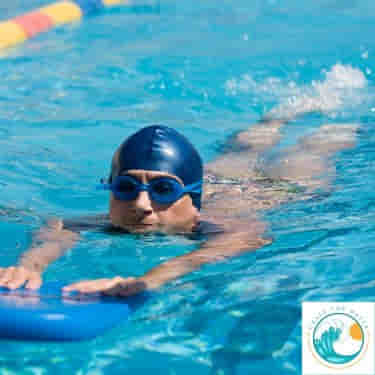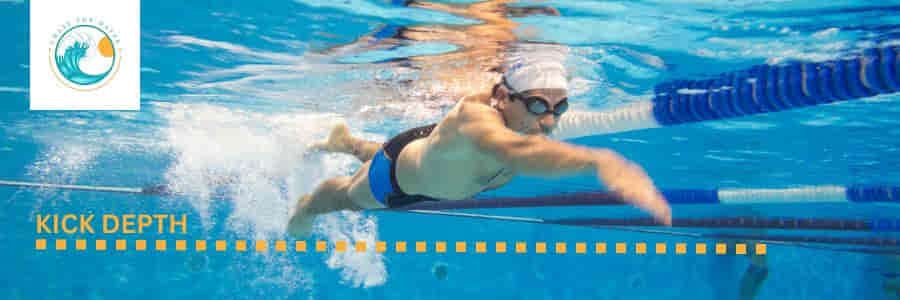The flutter kick is a fundamental skill in swimming. It is the primary kick used by the front crawl stroke (also known as freestyle) and can help you maintain a fast and well-balanced position in the water.
The flutter kick is characterised by a continuous up-and-down motion of the legs, moving from the hips and alternating an up-and-down motion of the legs, with the toes pointing down and a slightly bent knee.
The flutter kick is a basic swimming technique and can be very difficult for some swimmers to master when they are new to the sport. However, by having a good technique and keeping in mind some of the key aspects of the kick which I will cover in this article, you can improve your flutter kick overnight.
In this article I will answer:
- What is a flutter kick in swimming?
- Which strokes use a flutter kick?
- How do you flutter kick properly?
- Should I use a kickboard to practice flutter kicks?
- What are flutter kicks good for?

What Is A Flutter Kick In Swimming?
A flutter kick involves a fast and rhythmic motion of the legs, with each kick pushing down and up against the water, which moves the swimmer forward.
The flutter kick is the most prevalent kick used in swimming, especially when performing the front crawl (freestyle) and backstroke.
The flutter can have different rhythms and as you get more advanced, you can adapt a 2-beat, 4-beat or 6-beat flutter kick depending on how you swim, what distance you are covering and how fast you want to swim. I have covered the details of how much you should kick while swimming in greater detail in this article, How Much Should You Kick When Swimming?
The flutter kick is so-called as the legs seem to “flutter”. From a starting position with the legs straight behind the swimmer in the streamlined position, one leg kicks down into the water with a slightly bent knee. As this kicking leg returns to the surface, the other leg starts the downward kick motion.
I have covered the technical details of the flutter kick, including some important tips, later in this article.
As a beginner swimmer, the flutter kick will be one of the first kicks that you learn. It is a fundamental swim kick used for speed by elite swimmers and essential for body balance for all swimmers.
Which Strokes Use A Flutter Kick?
We primarily use the flutter kick in front crawl (freestyle) and backstroke swimming.
Generally, there are three different swim kicks which are:
- The flutter kick
- The dolphin kick
- The breaststroke kick
There are alternative swimming kicks which are less well known but are very effective such as the “scissor kick” which is primarily used for swimming the sidestroke and in lifesaving duties.
How Do You Flutter Kick Properly?
I recall attending swimming lessons as a child, where the swim teacher tried to teach us the flutter kick.
I recall holding onto a kickboard, kicking with every ounce of energy that I had, and staying nearly still in the water with little to zero forward motion. I never learned to swim through these swimming lessons.
I realise now that I remained almost stationary in the water because:
- I was trying to swim with a straight knee, which is a bad approach. They often teach this and I recall my swim teacher screaming this from the pool deck. Ensure you have a slight bend in the knee as you kick to increase propulsion.
- Flex the ankles. If you have rigid and tight ankles, which means your feet are stuck at a 90-degree angle in the water, you need to flex and point your toe. A vast amount of propulsion which comes from the flutter kick results from flexible ankles.
For many, myself included, learning how to do the flutter kick properly took time and patience.
Here are some top tips to help you start swimming with a good flutter kick style:
1. Kick From The Hips
The propulsion centre of the flutter kick is the hips. It is really important to kick from the hips as swim with a flutter kick.
If you watch good swimmers with excellent flutter kick technique, you will see their hips slightly roll from side to side as they swim.
Not only is this rolling motion helping them to stay balanced and glide through the water, but it is also greatly assisting their flutter kick technique.
2. Bend The Knee
As mentioned, there is a school of swimming teaching where a straight leg is encouraged. This is not a good way to swim the flutter kick as you get minimum propulsion. I have never seen a fast swimmer kick with a straight leg.
As you swim, have a slight bend in your knee. This will help you push down into the water, and the knee extension will help to flick your ankles, which gives maximum propulsion.
It also helps with the recovery, as your leg returns to the surface.
3. Do Not Kick Too Deep
A common mistake when swimming the flutter kick is to kick too deeply into the water.
Try to keep the depth of your kick within the outline of your body. For example, in the following image, we can see that the swimmer is keeping the depth of their flutter kick just below chest height and within the shadow of their body in the water.

As you swim, you need propulsion. However, your body creates drag. To swim easily and quickly, it is important to reduce this drag.
When you kick too deeply, you have to overcome the additional drag created by a deep kick, which is difficult. Your torso will start to rise to the surface as your legs sink, so it makes for an inefficient body position in the water.
Keep the depth of your kick controlled and within the outline of your body.
4. Improve Ankle Flexibility
Ankle flexibility is essential for an efficient flutter kick. A lot of the propulsion from the leg kicking actually comes from the ankles.
As the ankles flick, they can displace a lot of water, which will cause you to swim faster.
You can work on ankle flexibility both in and out of the pool. To learn how to improve ankle flexibility for swimming, I have covered this here: Is Ankle Flexibility The Secret To Swimming Faster?
5. Point The Toe
As you swim the flutter kick, it helps to point your toes. This will keep your ankles extended to get the most propulsion from the feet.
If your ankles are rigid, putting your feet at a 90-degree angle, you will not move much water and will remain still in the water, or even move backwards!
6. Practice Vertical Flutter Kicks
Sometimes it’s hard to practice your flutter kicks as a new swimmer, since you also have to factor in breathing.
If you do not have any training aids, a good approach is to practice vertical flutter kicks.
At the deeper end of the pool, hold on to the wall. Only enter the deeper end of the pool if you can safely tread water. Safety first.
Kick as you remain vertical in the water, holding onto the pool wall for support.
In this position, you can practice flutter kicks, building strength and experimenting with how your legs displace water.
The following video is a really great demonstration of how to swim the flutter kick properly from SwimGym.
Should I Use A Kickboard To Practice Flutter Kicks?
I recommend the use of a kickboard for any swimmer when practising their flutter kick. The kickboard provides extra stability and support and allows swimmers to focus on the technique without straining their arms.
Additionally, the board allows swimmers to practice a proper body position; they should be able to float with their hips and legs slightly above the water.
It is important to use a kickboard correctly, as the wrong technique can lead to poor results. You should hold it with both hands in front of the body at chest height, with elbows bent and shoulders relaxed.
Ensure that you are not straining your back when using a kickboard. Many new swimmers try to keep their heads far out of the water, with a tense body, in this case, the kickboard can do more damage than good, putting pressure on the back.
If you feel discomfort while swimming with a kickboard, stop. If you have a swim teacher, they can watch you swim with your kickboard and advise how you can shift your body position to make swimming with a kickboard easy, but stop if it is uncomfortable. [source]
The great thing about using a kickboard to practice the flutter kick is that you can build your technique by focusing purely on your legs; you do not have to worry about breathing or arm technique.
Another great training aid that can help you work on your flutter kick is to use a snorkel. A snorkel can allow you to place your face in the water, creating a good streamlined position, without worrying about your breathing.
Finally, if you struggle with the flutter kick, it can be useful to wear training fins. Training fins provide instant feedback on how efficient your swim kick is.
Using training fins can help with improving flexibility and teach you how to move your ankles effectively for the best propulsion.
To learn more about using training fins, I have created a full guide which you can read here.
What Are Flutter Kicks Good For?
The flutter kick is most effective when used in conjunction with other swimming techniques. For example, a strong flutter kick can help propel a swimmer forward while they pull their arms through the stroke. When done correctly, the kick will create lift and move the body more efficiently through the water.
For fast swimming, swimmers will use a 6-beat flutter kick, which involves taking six kicks per stroke cycle. [source]
The flutter kick is also beneficial for swimmers who are tired and need to conserve energy. Using the flutter kick to move forward can be less taxing on the body than other swimming strokes, making it a great technique for longer swims or races.
For efficient long-distance swimming, swimmers typically use a 2-beat flutter kick, which involves taking two kicks per stroke cycle. [source]
Final Thoughts
The flutter kick is an important technique for any swimmer to master. When done correctly, it can help swimmers move efficiently through the water and conserve energy.
Swimmers should practice this technique regularly to ensure they are getting the most out of their swimming. With practice, the flutter kick can become an integral part of any swimmer’s repertoire.
At first, the flutter kick might feel difficult to do, but once you synchronise your kicking pattern with your arm movements, the motion becomes effortless and you will swim the flutter kick without thinking too much about the details.
It is really important to get a good flutter kick technique from day one. However, if you are an advanced swimmer, there are always ways to build the strength of your kick and improve further.
Happy swimming!
